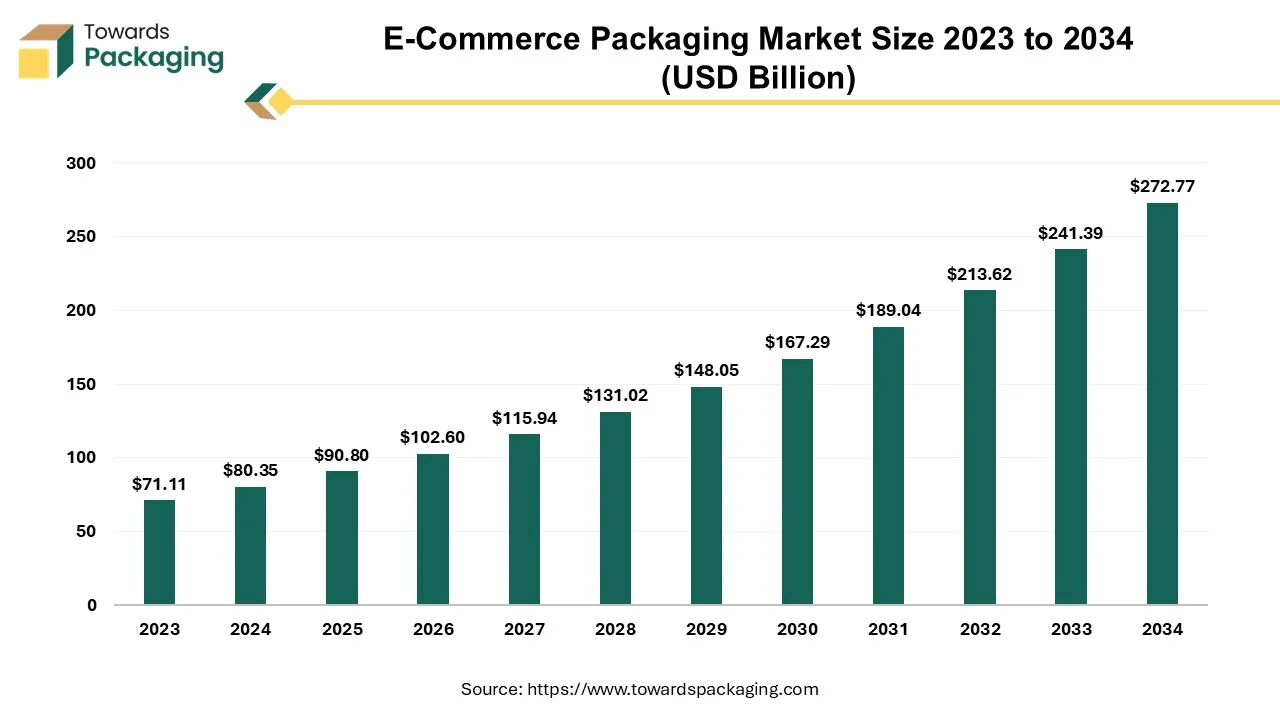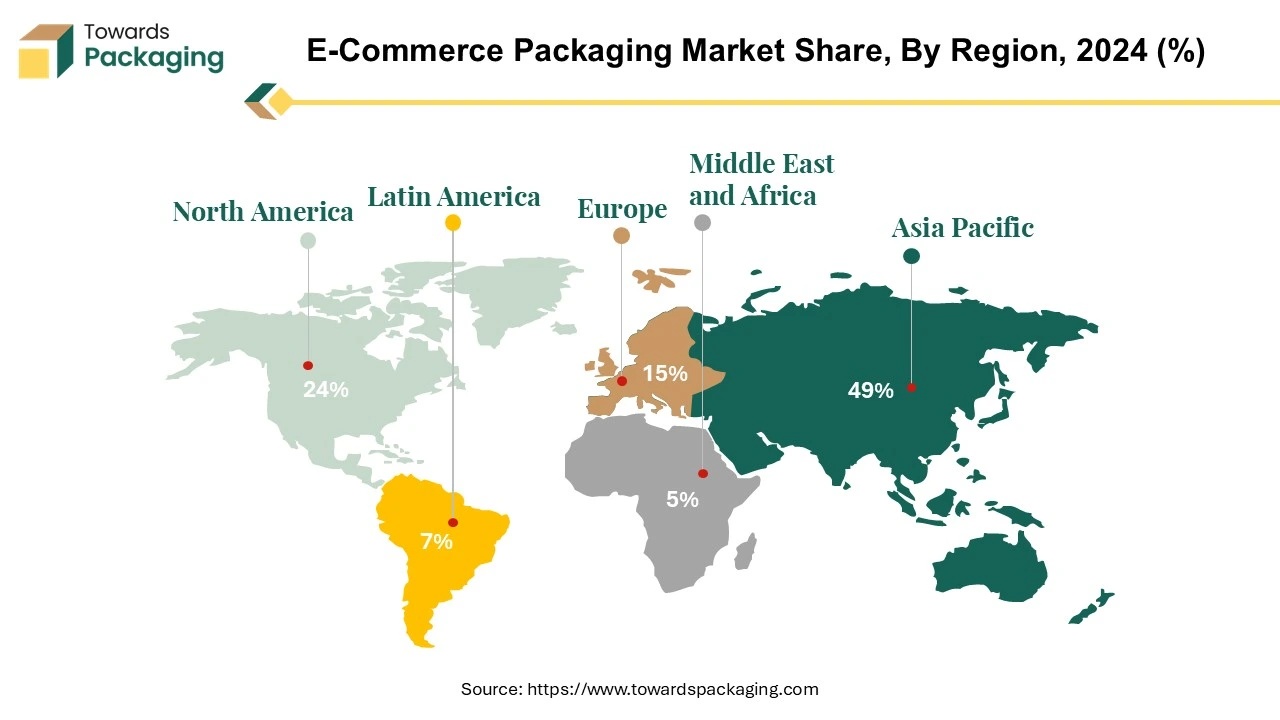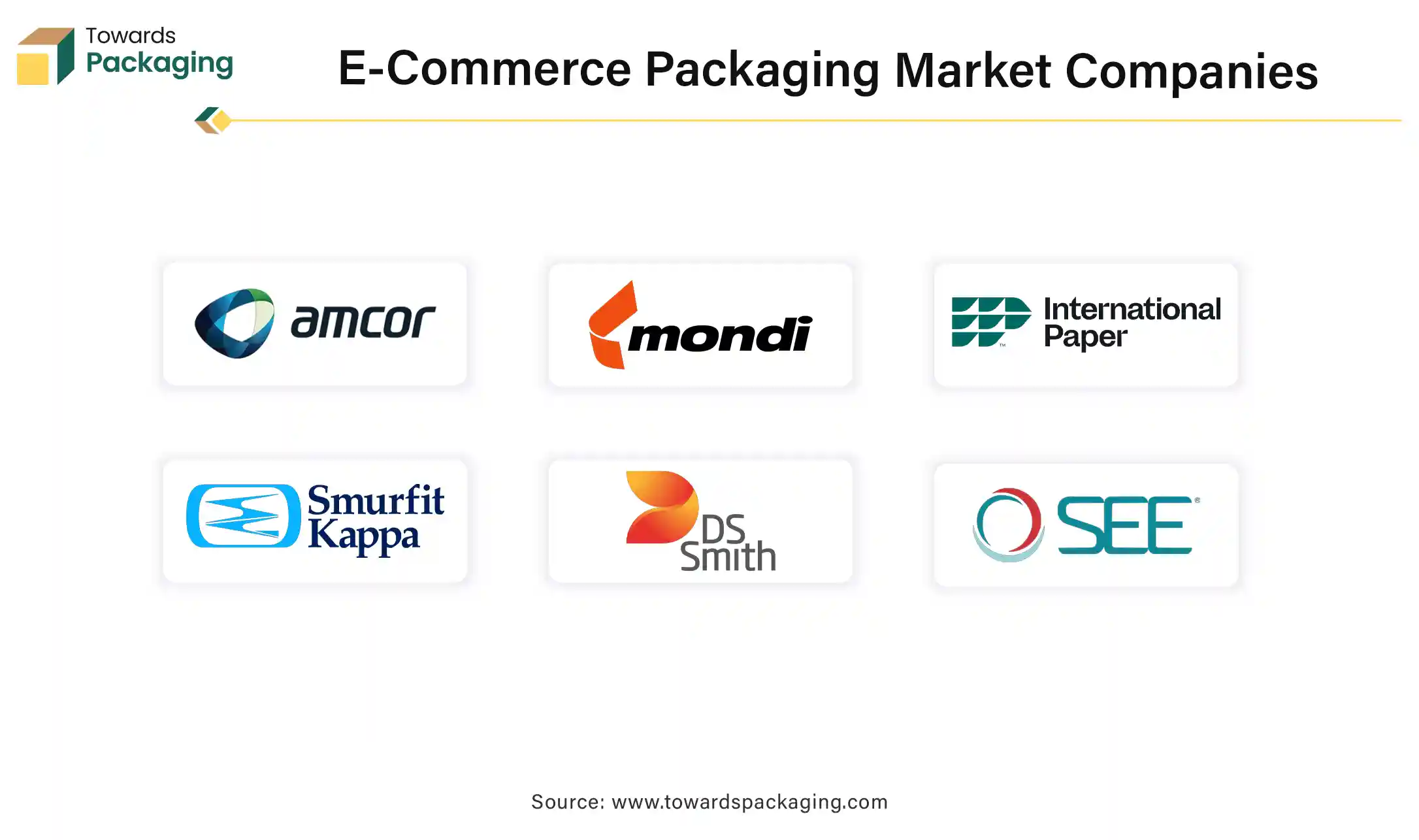October 2025
The e-commerce packaging market is expected to increase from USD 90.8 billion in 2025 to USD 272.77 billion by 2034, growing at a CAGR of 13% throughout the forecast period from 2025 to 2034. Growing environmental awareness among consumers and stringent government regulations are pushing companies to adopt sustainable, recyclable, and innovative packaging materials and technologies, further accelerating market growth.

The packaging specifically designed and used for products sold and shipped through online platforms. It’s tailored to protect products during shipping, enhance customer experience, and reflect brand identity in the digital retail environment is known as e-commerce packaging. The e-commerce packaging must withstand rough handling, stacking, and long-distance shipping. The E-commerce packaging includes padding, void-fill materials, and sturdy outer boxes.
Increasingly manufactured with compostable, recyclable, or minimal materials to reduce environmental impact. Brands often use eco-friendly alternatives to attract conscious consumers. The E-commerce packaging includes seals, tapes, or indicators to show if the package has been tampered with. Optimized to reduce shipping costs and environmental footprint without compromising product safety.
Companies use custom designs, inserts, and messaging to enhance the customer’s unboxing experience and encourage social sharing (e.g., on Instagram or TikTok). Designed for convenience, with resealable or reversible packaging for hassle-free returns. For instance, a branded cardboard box with bubble wrap for a tech gadget. A flexible insulated pouch for food delivery. A compostable mailer bag used by sustainable fashion brands.
The integration of artificial intelligence has revolutionized the e-commerce packaging by making it more sustainable, efficient, personalized and cost-effective. AI algorithms analyse product dimensions, weight, and fragility to recommend the perfect packaging size and material. The AI integration minimizes void space, minimizes packaging waste, and lowers shipping costs.
Commerce companies can enhance their targeted advertising with the aid of artificial intelligence. Al makes it simpler and more affordable to gather and examine real-time customer data, such as past purchases and online surfing patterns. Gaining insights from generated consumer data improves the efficacy of your marketing, which raises conversion rates and profitability.
PWC estimates that by 2030, corporate applications of Al could boost the world economy by up to US$15.7 trillion. Businesses can produce packaging that not only shines out on the store but also establishes a deeper connection with customers by incorporating Al into the design and branding process. In the end, this boosts sales and fosters brand loyalty by creating a more memorable consumer experience and a stronger brand identity.
Fast iteration and experimentation are made possible by Al-powered design platforms, which let designers rapidly test out several possibilities and hone their ideas. This quickness and adaptability guarantee that packaging ideas are timely and creative. Al can also analyse consumer preferences and design trends, offering insightful information that helps guide the design process and guarantee that the finished product is both aesthetically beautiful and profitable.
The surge in online retail, especially post-COVID-19, has created a massive demand for durable, efficient, and branded packaging. Sectors like fashion, electronics, groceries and beauty heavily depend on specialized e-commerce packaging. Eco-conscious consumers are pushing brands to adopt recyclable, reusable, and biodegradable packaging solutions. Sustainable packaging has become a key purchase influencer in many mistakes.
The key players operating in the e-commerce packaging market are facing issue due to regulatory compliance across borders, volatility in raw material prices and complexity in reverse logistics which has estimated to restrict the growth of the market. Returns are common in e-commerce, and packaging must be durable and return-friendly, adding design and material challenges.
Improperly handled returns can lead to product damage and increased costs. Fluctuations in the cost of packaging materials such as cardboard, plastics, and inks can affect profit margins and pricing stability. International e-commerce involves navigating varied regulations on packaging, labelling, and materials across countries. This complexity increases operational burdens and can delay market entry.
There’s a growing demand for eco-friendly packaging (e.g., recyclable, reusable, compostable materials). Companies that develop affordable, scalable green alternatives have major growth potential. Government regulations and consumer preferences are also pushing brands in this direction. Opportunities are present in technologies like RFID, QR codes, NFC chips, and smart sensors that improve product tracking, authentication, and customer engagement. Especially valuable in food, healthcare, and luxury goods sectors.
The corrugated boxes segment held a dominant presence in the e-commerce packaging market in 2024. Corrugated boxes provides excellent protection against impact, pressure, and rough handling during shipping. The fluted inner layer adds rigidity and cushioning, making them ideal for fragile or valuable items. Despite their strength, they are lightweight, which helps reduce shipping costs. Corrugated boxes are easily customized in shape, size, and print, which is perfect for branded unboxing experiences.
The corrugated board segment accounted for a considerable share of the e-commerce packaging market in 2024. Corrugated boards are lightweight yet extremely strong due to their fluted (wavy) inner layer. This structure absorbs shocks and resists compression, protecting products during shipping and handling. Corrugated boards are ideal for long-distance shipping and frequent handling across distribution center.
The food & beverages segment registered its dominance over the global e-commerce packaging market in 2024. With growing environmental awareness, both consumers and brands are prioritizing eco-friendly packaging options. The food & beverages sector is responding by adopting recyclable, biodegradable, and reusable packaging materials, aligning with broader sustainability goals and driving innovation in packaging solutions.
Shipping perishable and temperature-sensitive items like meats, dairy products, and beverages requires specialized packaging that maintains product integrity. This includes insulated materials, moisture-resistant coatings, and tamper-evident features, thereby expanding the scope and innovation within the e-commerce packaging industry.
Asia Pacific region held the largest share of the e-commerce packaging market in 2024, owing to booming e-commerce platform. Countries like China, India, Vietnam, and Indonesia have experienced unpredictable growth in online shopping, fuelled by increased smartphones penetration and improved internet infrastructure. The Asia Pacific region, particularly China, boasts a strong manufacturing base with advanced packaging infrastructure. Investments in automated packaging facilities, smart logistics center, and research into new materials have positioned the Asia Pacific region as a key supplier of packaging materials to both domestic and international markets.
China e-commerce packaging market dominates global e-commerce sales, with platform such as JD.com and Alibaba handling billions of packages annually, creating massive demand for packaging solutions. China’s advanced logistics infrastructure and innovative packaging solutions provide an added boost to the market presence of the Asia Pacific region. The swift online retail expansion in countries like China has driven by increasing internet penetration and an expanding middle class, leads to soaring demand for e-commerce packaging.

North America region is anticipated to grow at the fastest rate in the e-commerce packaging market. As the North America region has well equipped machinery and infrastructure for e-commerce packaging, it has observed to drive the growth of the e-commerce packaging market in the region. The integration of technology in packaging, including smart packaging solutions with NFC tags, QR codes, and RFID chips, enhances customer engagement and offers real-time tracking. Automation and robotics are also streamlining packaging processes in e-commerce warehouses.
U.S. e-commerce packaging market is driven owing to large consumer base via social media platform has taken raise within teenagers. The surge in online shopping across the U.S. has significantly increased the demand for e-commerce packaging solutions. The convenience and accessibility of online platforms have led to a higher volume of packages requiring efficient and protective packaging.
Europe region is seen to grow at a notable rate in the foreseeable future. The European Union (EU) has implanted rigorous environmental policies, such as the Packaging and Packaging Waste Directive, which mandates the use of recyclable materials and promotes waste reduction. Initiatives like the European Green Deal and the Circular Economy Action Plan further encourage businesses to adopt sustainable packaging solutions.
These regulations compel companies to innovate and align their packaging practise with environmental standards. European consumers exhibit a strong preference for eco-friendly products, influencing companies to prioritize sustainable packaging.

By Material
By Product
By Application
By Region
October 2025
October 2025
October 2025
October 2025